Feathered serpent pendant
This pendant, which retains the shape of a cross-section of a conch shell, features delicately incised imagery of a feathered serpent on one side, and its coiled, rattlesnake-like tail on the other. The head of the serpent, at the center of the ornament, is seen in a dorsal view, with two eyes drilled on either side of the creature’s feathered snout. The serpent’s feathered body is coiled around the center void, with two human hands emerging from either end, along with two legs at the center. Leonardo López Luján has identified the flower held in one hand as a huacalxóchitl, the Nahuatl name for Philodendron affine, a plant associated with sensuality and pleasure. (Nahuatl was the language of the Mexica, the ruling group of the Aztec Empire.) The other hand grasps what may be a knife.
This type of pendant is known as an ehecacozcatl or "wind jewel," an ornament often associated with Quetzalcoatl-Ehecatl, the creator and Wind God (for a depiction of a spider monkey wearing this regalia see accession number 2017.393). This tiny, exquisitely carved ornament contains multiple, layered meanings, from the general associations of the very material from which it was carved—shell, with its connections to warriors, and, most importantly, water and fertility—to specific associations with deities such as Quetzalcoatl. What is clear is that such ornaments were highly esteemed in Aztec times. As Adrián Velazquez Castro has noted, shell workshops were likely located within royal palaces, and their use appears to have been reserved for the private ceremonies of the Mexica elite. Such an ornament speaks to an extraordinary control over access to resources, from the raw material itself—from far away and difficult to acquire—to access to the finest artists, individuals with the skill required to transform the material into works of great beauty and delicacy.
Joanne Pillsbury Andrall E. Pearson Curator, Arts of the Ancient Americas, 2020
References and further reading
López Austin, Alfredo, and Leonardo López Luján. "Alcatraz / Huacalxóchitl: Símbolo de la sensualidad e instrumento de placer." Arqueología Mexicana XXV (2017): pp. 18-27.
López Luján, Leonardo. "Mexica Gold." In Golden Kingdoms: Luxury Arts in the Ancient Americas, edited by Joanne Pillsbury, Timothy F. Potts, and Kim Richter, pp. 110-121. Los Angeles: The J. Paul Getty Museum, 2017.
López Luján, Leonardo. The Offerings of the Templo Mayor of Tenochtitlan. Albuquerque, NM: University of New Mexico Press, 2005.
Velázquez Castro, Adrián. "Luxuries from the Sea." In Golden Kingdoms: Luxury Arts in the Ancient Americas, edited by Joanne Pillsbury, Timothy F. Potts, and Kim Richter, pp. 90-97. Los Angeles: The J. Paul Getty Museum, 2017.
Velázquez Castro, Adrián. El simbolismo de los objetos de concha del Templo Mayor de Tenochtitlan. Mexico City: INAH, 2000.
This image cannot be enlarged, viewed at full screen, or downloaded.
This artwork is meant to be viewed from right to left. Scroll left to view more.




